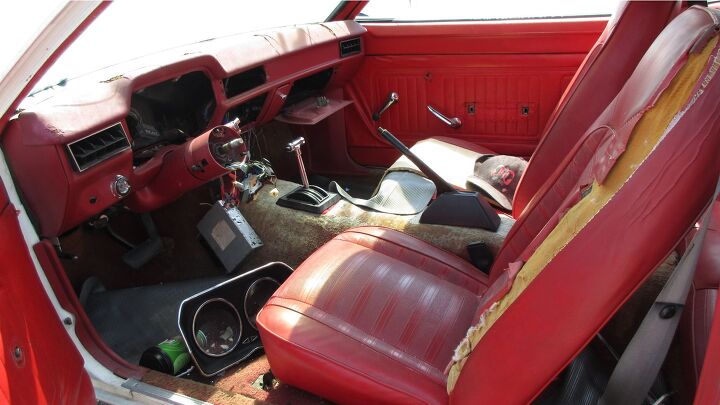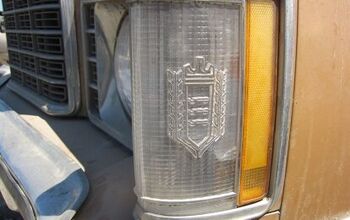Junkyard Find: 1977 Ford Pinto

Ford sold more than three million Pintos during the 1971-1980 period, though most of those were 1974 and earlier models. By 1977, Corollas and Civics and Rabbits had taken a big bite out of Pinto sales, so these later cars are even more uncommon in junkyards than their older brethren. Not that Pintos are easy to find in your local U-Wrench-It yard; most of these cars were crushed long before the end of the 1990s.
Here’s a ’77 I spotted a few days ago in a Denver self-service yard.
Before today’s Junkyard Find, we’d seen this ’72 Pinto wagon and this ’74 hatchback, and that’s it. Pinto-based Mustang IIs are easier to find these days, in fact.
This one was reasonably well-optioned, with Whorehouse Red vinyl interior and automatic transmission.
Speaking of Pintos with automatics, my ’68 Mercury Cyclone had a Pinto floor shifter just like this one (retrofitted after the column shifter mechanism failed and couldn’t be fixed with easy-to-find junkyard parts).
Power came from an 89-horsepower 2.3-liter engine. In 2.5-liter form, this engine was used in Ford Rangers into our current century.
The Mother Jones story Pinto Madness made the car the butt of a million “exploding rear-ended Pinto” jokes. The story was in the September 1977 issue, just in time for the new owner of today’s Junkyard Find to witness the start of the car’s even-more-rapid-than-expected value depreciation.
The ’77 Pinto was able to beat the Corolla and B210 in a hillclimb test. Which isn’t surprising, as those cars were even more miserably underpowered than the little Ford.

Murilee Martin is the pen name of Phil Greden, a writer who has lived in Minnesota, California, Georgia and (now) Colorado. He has toiled at copywriting, technical writing, junkmail writing, fiction writing and now automotive writing. He has owned many terrible vehicles and some good ones. He spends a great deal of time in self-service junkyards. These days, he writes for publications including Autoweek, Autoblog, Hagerty, The Truth About Cars and Capital One.
More by Murilee Martin
Latest Car Reviews
Read moreLatest Product Reviews
Read moreRecent Comments
- MaintenanceCosts Nobody here seems to acknowledge that there are multiple use cases for cars.Some people spend all their time driving all over the country and need every mile and minute of time savings. ICE cars are better for them right now.Some people only drive locally and fly when they travel. For them, there's probably a range number that works, and they don't really need more. For the uses for which we use our EV, that would be around 150 miles. The other thing about a low range requirement is it can make 120V charging viable. If you don't drive more than an average of about 40 miles/day, you can probably get enough electrons through a wall outlet. We spent over two years charging our Bolt only through 120V, while our house was getting rebuilt, and never had an issue.Those are extremes. There are all sorts of use cases in between, which probably represent the majority of drivers. For some users, what's needed is more range. But I think for most users, what's needed is better charging. Retrofit apartment garages like Tim's with 240V outlets at every spot. Install more L3 chargers in supermarket parking lots and alongside gas stations. Make chargers that work like Tesla Superchargers as ubiquitous as gas stations, and EV charging will not be an issue for most users.
- MaintenanceCosts I don't have an opinion on whether any one plant unionizing is the right answer, but the employees sure need to have the right to organize. Unions or the credible threat of unionization are the only thing, history has proven, that can keep employers honest. Without it, we've seen over and over, the employers have complete power over the workers and feel free to exploit the workers however they see fit. (And don't tell me "oh, the workers can just leave" - in an oligopolistic industry, working conditions quickly converge, and there's not another employer right around the corner.)
- Kjhkjlhkjhkljh kljhjkhjklhkjh [h3]Wake me up when it is a 1989 635Csi with a M88/3[/h3]
- BrandX "I can charge using the 240V outlets, sure, but it’s slow."No it's not. That's what all home chargers use - 240V.
- Jalop1991 does the odometer represent itself in an analog fashion? Will the numbers roll slowly and stop wherever, or do they just blink to the next number like any old boring modern car?











































Comments
Join the conversation
Saw this on the U-Pull-&-Pay website last night. Someone snagged that left fender because in their pic it's still there. They have a 1977 Granada at the moment too. Last time I was there, there was a '71 Thunderbird with no engine. I have the beak-face grille on my wall right now.
I learned to drive stick in a '71 with a 1.6L Kent. It was the sweetest handling car I ever drove, and bone reliable. A friend had a '76 with the 2.8L Cologne, a hand crank moonroof, and Craigers. We would all pile in and take the girls to the Dairy Dell for fancy ice cream cones. It was fun.